Gildas › Book of Kells » Ancient origins
Articles and Definitions › Contents
- Gildas › Who Was
- Book of Kells › Antique Origins
Ancient civilizations › Historical and archaeological sites
Gildas › Who Was
Definition and Origins
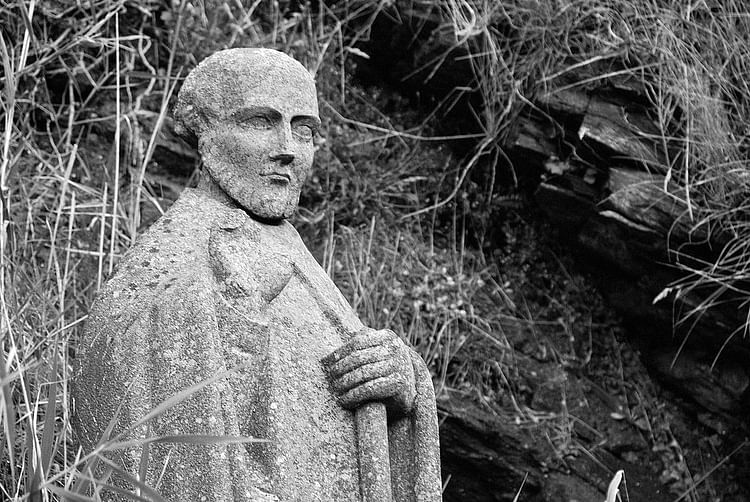
Gildas (c. 500-570 CE) was a Romano-British monk, known primarily for a work entitled De Excidio et Conquestu Britanniae, translated as On the Ruin and Conquest of Britain. Gildas' work is a polemical sermon recounting British history while also rebuking the British kings and clergy of his own lifetime. While little is known of Gildas himself, it is generally accepted that he was writing at some point in the mid-6th century CE. He probably lived near western Britain, modern-day Wales and Cornwall.Later in life, he emigrated to Brittany in what is now northwestern France. There he joined many of his fellow Britons fleeing the oncoming Germanic invaders. Gildas founded there the monastery which came to be known as St. Gildas de Rhuys and he came to be venerated as a saint; at times referred to as Saint Gildas Sapiens, or Saint Gildas the Wise.
LIFE OF GILDAS
The year of Gildas' birth is generally dated to no earlier than c. 500 CE. Gildas himself claims that he was born in the same year that the Battle of Mount Badon was fought. He claims in his own writing that it had been roughly 40 years since the battle.This suggests that he was roughly 40 years old at the time. The location of his birth is unknown and has been the subject of debate. Very little is known about Gildas himself, and almost none of the tradition surrounding his life can be accepted with certainty. The geography of On the Ruin and Conquest of Britain seems to suggest that he was living and writing somewhere in close proximity to the western British kingdoms in modern-day Wales and Cornwall. Scholars have noted that he reveals little about his own identity, perhaps for fear of reprisal for his criticisms. It is believed by scholars that On the Ruin and Conquest of Britain was written in the mid-sixth century, possibly in the 540s CE.
GILDAS FOUNDED THE MONASTERY OF ST. GILDAS DE RHUYS IN NORTHWEST FRANCE.
Several sources for Gildas' life have survived from the ancient and medieval periods. These include two hagiographic accounts, written in the 9th and 12th centuries CE respectively. Gildas also appears in works such as the Annales Cambriae('The Annals of Wales'), a collection of sources for ancient and early medieval Welsh history. This account also dates to centuries after Gildas' death. Much of the information provided in these accounts is purely legendary. It is known that at some point Gildas emigrated to Brittany, joining many Romano-British who fled the Anglo- Saxons. It was here that he founded the monastery of St. Gildas de Rhuys. His death is generally dated at c. 570 CE.
Aside from On the Ruin of Britain, several other surviving fragments of writing are attributed to Gildas. There are several letter fragments and a penitential. He was a prominent figure in the generations following his death. His authority in monastic matters was sufficient for him to warrant the attention of Columbanus in a letter written to Pope Gregory the Great. He is also cited at length both in the Irish canonical collection known as the Collectio canonum Hibernensis ('Irish Collection of Canon Law') and in Bede ’s Historia Ecclesiastica Gentis Anglorum ('Ecclesiastical History of the English People').
ON THE RUIN & CONQUEST OF BRITAIN
On the Ruin and Conquest of Britain is a lengthy sermon consisting of three main sections:
- A chronicle of the history of Roman Britain.
- A diatribe against five British kings ruling in areas of Western Britain during Gildas' lifetime.
- A sermon criticizing the British clergy of the 6th century CE and offering them examples from the Bible of proper behavior for men of their occupation.
In Part I of his work, Gildas provides an explanatory preface for his writing. In his preface, Gildas explains that his purpose in writing is to illustrate the sins of his people and to show them a better way. He then begins a narrative of the history of his homeland from the Roman conquest to the Britain of his lifetime. He does not provide a coherent historical narrative, but rather offers a series of events illustrating sin and divine punishment in the history of Roman Britain. This section features distinct episodes throughout the history of Roman Britain. Gildas begins with the conquest of Britain by the Roman Empire.He details various rebellions, the rise of Christianity and subsequent persecutions, and an examination of the decline of Roman Britain. Here Gildas concerns himself with a series of both political and religious rebellions. He mentions the rebellions of the British queen Boudicca and later of the Roman general Magnus Maximus. He also discusses the persecutions of early Christians, early British martyrs, and heresies such as Arianism. Gildas tries to show in this narrative that the wickedness of the Britons repeatedly results in their own folly.
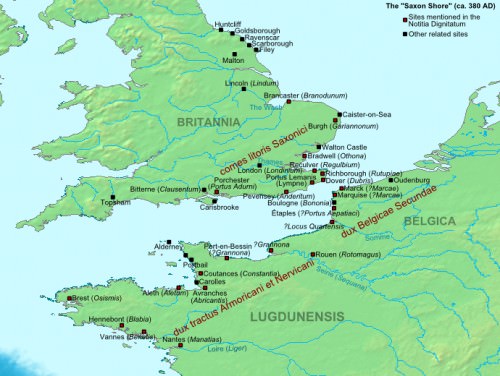
Map of the Saxon Shore, c. 380 CE
Gildas traces the ultimate decline of Roman Britain from the episode of Magnus Maximus. He blames Maximus for bringing virtually the whole of Roman military strength with him in his misguided rebellion. Gildas provides perhaps the earliest recorded mention of the Groans of the Britons, or the account of the appeals of the citizens of Roman Britain to the continent for aid against Picts and Scots raiders. According to Gildas, the appeal was made to one Agitius, who is generally identified with the general Flavius Aetius. When Aetius turned them down, Gildas writes that the British authorities were forced to hire out Saxon mercenaries to help them fight off their encroaching neighbors. It was these Saxon mercenaries, according to Gildas, who revolted against their British hosts. This episode began a string of conquests of the country that lasted until the very year of Gildas' birth. Gildas repeatedly compares the Saxons to wild beasts, referring to them as wolves and dogs among other metaphors. Gildas claims that a battle at a place called Mons Badonicus, or Mount Badon, was a major victory for the Britons under Ambrosius Aurelianus in the year of his own birth. From this battle on, there was peace for roughly 40 years until the time of his writing.
GILDAS WROTE A VIGOROUS DENOUNCEMENT OF FIVE DIFFERENT BRITISH KINGS RULING IN DIFFERENT AREAS IN WESTERN BRITAIN.
Part II is a vigorous denouncement of five different British kings ruling in different areas in western Britain at the time of Gildas' writing. The first king named is Constantine of Dumnonia (modern-day Cornwall). Gildas derides him and refers to him as the 'tyrannical whelp of that unclean lioness of Dumnonia.' The lioness in question is never herself named. The second king is Aurelius Caninus (Canonus), also a 'lion's whelp' who commits 'horrible murders, fornications, and adulteries.' The next is Vortipor of the Demetae, 'the naughty son of a good King.' The fourth is Cuneglasus (Cuneglasse) of Dineirth, singled out for mistreatment of his wife as well as for rapacious behavior regarding his subjects. Finally, Gildas names Maglocunus (Maelgwn) 'Dragon of the Island' (Island of Anglesey), a violent usurper who apparently overthrew his own uncle to become king. Gildas calls them tyrants and laments that they are more interested in terrorizing their own people than in defending the lands of their ancestors from the marauding Saxons. The portraits of these five different kings display significant character flaws both in their personal lives and in their treatment of their subjects.
The remainder of the work is a lengthy reproval of the British clergy of Gildas' day. Gildas reproaches his fellow clergymen for a number of faults including drunkenness, greed, and a general fixation on lay pursuits. He provides a number of Biblical examples to illustrate the righteous path to his fellow churchmen. Aside from identifying himself with Jeremiah in his preface, Gildas goes through a veritable catalog of Old Testament prophets in his warning to the British. Samuel, Hosea, Amos, Zephaniah, Haggai, and Malachi are all quoted and examined as warnings to the clergy to lead better and more holy lives in addition to other Biblical figures.
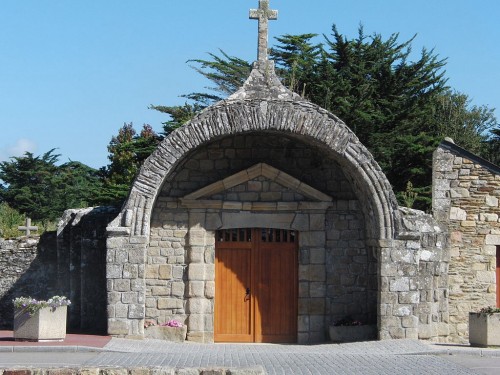
Monastery of Saint-Gildas-de-Rhuys
LEGACY OF GILDAS
Gildas is one of the only sources from late Roman Britain to shed any light on the early movements of the 5th and 6th century CE Germanic invaders. Gildas was seen as an authoritative figure in monastic matters for generations following his death. He is mentioned in a letter written by Columbanus to Pope Gregory the Great and he is also cited as an authority in the Collectiocanonum Hibernensis, probably compiled in the 7th or 8th century CE. His relics were venerated at Rhuys for generations before they were transferred to Berry in the 10th century CE. Though his chronicle of the Germanic migrations to Britain can hardly be accepted as history today, his work loomed large over later generations of Anglo-Saxon leaders, both lay and clerical, particularly when it was used by Bede for the early parts of his own history.
Book of Kells › Antique Origins
Definition and Origins
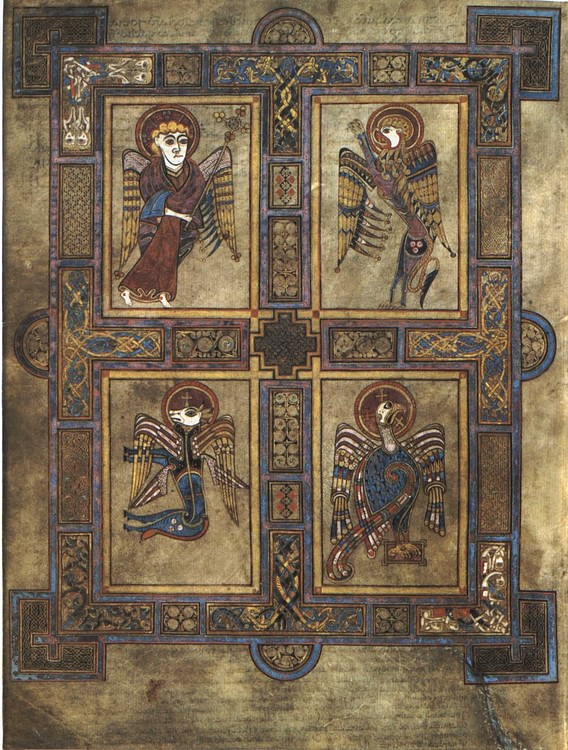
The Book of Kells (c. 800 CE) is an illuminated manuscript of the four gospels of the Christian New Testament, currently housed at Trinity College, Dublin, Ireland. The work is the most famous of the medieval illuminated manuscripts for the intricacy, detail, and majesty of the illustrations. It is thought the book was created as a showpiece for the altar, not for daily use, because more attention was obviously given to the artwork than the text.
The beauty of the lettering, portraits of the evangelists, and other images, often framed by intricate Celtic knotwork motifs, has been praised by writers through the centuries. Scholar Thomas Cahill notes that, “as late as the twelfth century, Geraldus Cambrensis was forced to conclude that the Book of Kells was “the work of an angel, not of a man” owing to its majestic illustrations and that, in the present day, the letters illustrating the Chi-Rho (the monogram of Christ) are regarded as “more [living] presences than letters” on the page for their beauty (165). Unlike other illuminated manuscripts, where text was written and illustration and illumination added afterwards, the creators of the Book of Kells focused on the impression the work would have visually and so the artwork was the focus of the piece.
ORIGIN & PURPOSE
The Book of Kells was produced by monks of St. Columba's order of Iona, Scotland, but exactly where it was made is disputed. Theories regarding composition range from its creation on the island of Iona to Kells, Ireland, to Lindisfarne, Britain.It was most likely created, at least in part, at Iona and then brought to Kells to keep it safe from Viking raiders who first struck Iona in 795 CE, shortly after their raid on Lindisfarne Priory in Britain.
A Viking raid in 806 CE killed 68 monks at Iona and led to the survivors abandoning the abbey in favor of another or their order at Kells. It is likely that the Book of Kells traveled with them at this time and may have been completed in Ireland. The oft-repeated claim that it was made or first owned by St. Columba (521-597 CE) is untenable as the book was created no earlier than c. 800 CE; but there is no doubt it was produced by later members of his order.
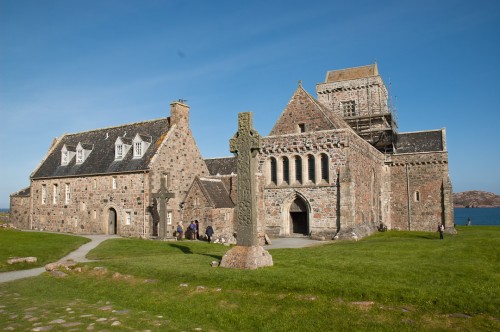
Iona Abbey
The work is commonly regarded as the greatest illuminated manuscript of any era owing to the beauty of the artwork and this, no doubt, had to do with the purpose it was made for. Scholars have concluded that the book was created for use during the celebration of the mass but most likely was not read from so much as shown to the congregation.
This theory is supported by the fact that the text is often carelessly written, contains a number of errors, and at points certainly seems an afterthought to the illustrations on the page. The priests who would have used the book most likely already had the biblical passages memorized and so would recite them while holding the book, having no need to read from the text.
Scholar Christopher de Hamel notes how, in the present day, “books are very visible in churches” but that in the Middle Ages this would not have been the case (186). De Hamel describes the rough outline of a medieval church service:
There were no pews (people usually stood or sat on the floor), and there would probably have been no books on view. The priest read the Mass in Latin from a manuscript placed on the altar and the choir chanted their part of the daily office from a volume visible only to them. Members of the congregation were not expected to join in the singing; some might have brought their Books of Hours to help ease themselves into a suitable frame of mind, but the services were conducted by the priests. (186)
The Book of Kells is thought to have been the manuscript on the altar which may have been first used in services on Iona and then certainly was at the abbey of Kells. The brightly-colored illustrations and illumination would have made it an exceptionally impressive piece to a congregation, adding a visual emphasis to the words the priest recited while being shown to the people;much in the way one today would read a picture book to a small child.
APPEARANCE & CONTENT
The book measures 13x10 inches (33x25 cm) and is made of vellum pages decorated in painted images which are accompanied by Latin text written in insular script in various colors of ink. It includes the complete gospels of Matthew, Mark, and Luke, and part of John as well as indexes and cross-references, summaries, and commentary. It was originally bound by a cover of gold and jewels which was lost when the manuscript was stolen from the abbey in 1007 CE. The ornate binding, front and back, was torn off by the thieves, which also resulted in the loss of some of the folios at either end, and this may have been when the latter part of the Gospel of John was lost.
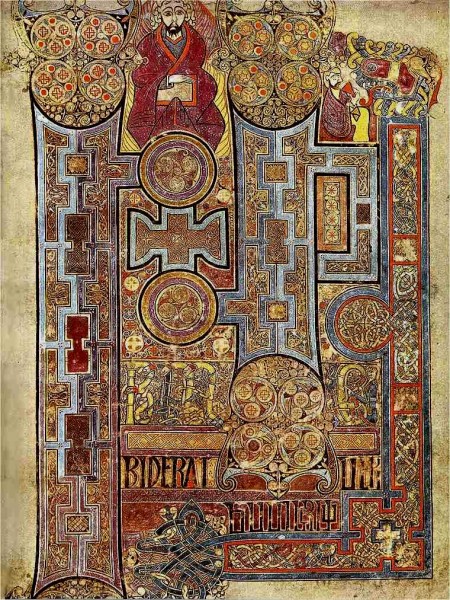
Book of Kells
It is also possible, however, that John may never have been completely copied. There is evidence that the Book of Kells is an unfinished manuscript. There are blank pages, for example, and some missing illustrations; although these may have been lost rather than never completed. The work was done by three separate anonymous scribes who are identified in the present day only as Hand A, Hand B, and Hand C. It was common for more than one scribe to work on a manuscript – even on a single page of a book – to proofread and correct another's errors or to illuminate a text already copied.
CREATION
Monks produced illuminated manuscripts between the 5th and 13th centuries CE. After the 13th century CE, professional book-makers emerged to meet the growing demand for literary works. It was a natural outgrowth of the monastic life that monks should be the first copyists and creators of books. Each monastery was required to have a library as dictated by the rules of St. Benedict of the 6th century CE. Even though it is clear that some monks arrived at these places with their own books, it is equally evident that many others were borrowed from elsewhere and copied.
MONKS WERE INVOLVED IN EVERY ASPECT OF BOOK-MAKING FROM THE CULTIVATION OF THE ANIMALS WHOSE SKIN WOULD BE USED FOR THE PAGES TO THE FINISHED PRODUCT.
Monks who worked on books were known as scriptores and worked in rooms called scriptoriums. The scriptorium was a long room, lit only by the light from the windows, with wooden chairs and writing tables. A monk would sit hunched over these tables, which angled upwards to hold manuscript pages, day after day to complete a work. Candles or oil lamps were not allowed in the scriptorium to maintain the safety of the manuscripts as fire was an obvious and significant threat.
Monks were involved in every aspect of book-making from the cultivation of the animals whose skin would be used for the pages, to processing that skin into vellum, and on further to the finished product. Once the vellum was processed, a monk would begin by cutting down a sheet to size. This practice would define the shape of books from that time down to the present day; books are longer than they are wide because the monks needed a taller page to work on.
Once the vellum sheet was prepared, lines would be drawn across it to serve as rules for text and blank spaces left open on the sides and borders for illustrations. The text was written first in black ink between these ruled lines by one monk and then would be given to another to proofread. This second monk would then add titles in blue or red ink and then pass the page on to the illuminator who would add images, color, and the silver or gold illumination. Monks wrote with quill pens and boiled iron, tree bark, and nuts to make black ink; other ink colors were produced by grinding and boiling different natural chemicals and plants.
ILLUMINATION
The images in the Book of Kells (and other illuminated manuscripts) are called miniatures. Scholar Giulia Bologna explains:
The term miniature is derived from miniare, which means `to colour in red'; minium is the latin name for cinnabar or mercuric sulphide. This red, used in wall -paintings at Pompeii, was put to common use colouring the initials of early codices, hence its name became the term used to indicate pictures in manuscript books. (31)
The artists who painted these works were known as miniaturists but later as illuminators. The illuminator would begin with a sheet of vellum on which text had usually already been written. The section of the page to be worked on would be rubbed by the monk with clay or isinglass or with "a mixture of ox-bile and egg-albumen or by rubbing the surface with cotton-wool dipped in a diluted glue-and-honey solution" (Bologna, 32). Once the surface was prepared, the monk readied his brushes - which were made of the hair of squirrel tails pressed into a handle - as well as his pens and paints and set to work. Errors in the image were erased by rubbing them away with chunks of bread.

Book of Kells
According to Bologna, "we learn of the techniques of illumination from two sources: from uncompleted manuscripts that allow us to observe the interrupted stages of the work and from the directions compiled by medieval authors" (32). The illuminator would begin by sketching an image and then tracing it onto the vellum page. The first layer of paint would be applied to the image and then left to dry; afterwards, other colors were applied. Gold or gold leaf was the first on the page to provide the illumination highlighted by the colors which followed. In this way, the great Book of Kells was produced.
HISTORY
Although it is clear how the manuscript was probably made, no consensus has ever been reached on where it was created.Christopher de Hamel writes:
The Book of Kells is a problem. No study of manuscripts can exclude it, a giant among giants. Its decoration is of extreme lavishness and the imaginative quality of its workmanship is quite exceptional. It was probably this book which Giraldus Cambrensis, in about 1185, called “the work of an angel, not of a man”. But in the general history of medieval book production the Book of Kells has an uncomfortable position because really very little is known about its origin or date. It may be Irish or Scottish or English. (21)
However that may be, most scholars agree on either a Scottish or Irish origin for the work and, since the monks of Iona were originally from Ireland, Irish influence is considered most prominent. The Book of Durrow (650-700 CE), certainly created in Ireland and predating the Book of Kells by more than century, shows many of the same techniques and stylistic choices.Thomas Cahill, writing on the development of literacy and book-making in Ireland, comments:
Nothing brought out Irish playfulness more than the copying of the books themselves…they found the shapes of letters magical. Why, they asked themselves, did a B look the way it did? Could it look some other way? Was there an essential B-ness? The result of such why-is-the-sky-blue questions was a new kind of book, the Irish codex; and one after another, Ireland began to produce the most spectacular magical books the world had ever seen. (165)
Cahill goes on to note how the Irish monks combined the letters of the Roman alphabet with their own Ogham script and whatever fancies their imagination leaned them to produce the opening capital letters on the page, the headings, and the borders which framed the miniatures. Wherever the Book of Kells was started or finished, the Irish touch is unmistakable throughout the work.
As noted, it most likely came to Kells from Iona in 806 CE following the worst of the Viking raids on the island and is known to have been stolen in 1007 CE when its cover was lost; the text itself was found discarded. It is considered most likely the same book Giraldus Cambrensis so admired at Kildare in the 12th century CE but, if he is correct about this location, it was back at the abbey of Kells in the same century as land charters pertaining to the abbey were written on some of the pages.
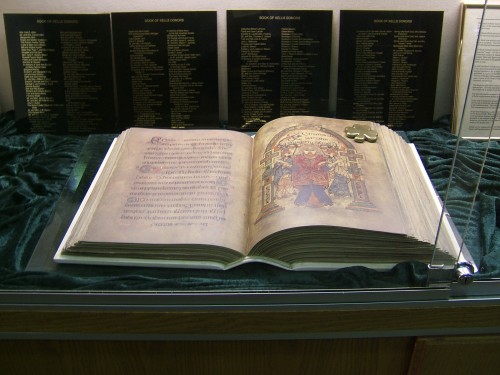
The Book of Kells
It remained at the abbey until the 17th century CE when Oliver Cromwell invaded Ireland (1649-1643 CE) and stationed a part of his force at Kells; at this time the manuscript was brought to Dublin for safe-keeping. It came into the hands of the bishop Henry Jones (1605-1682 CE), an alumnus of Trinity College, and Jones donated it to the college's library in 1661 CE along with the Book of Durrow. The manuscript has been housed at the Trinity library ever since. In 1953 CE the book was rebound in four separate volumes to help preserve it. Two of these volumes are on permanent display at Trinity College; one showing a page of text and the other a page of illustration.
In 2011 CE the town of Kells mounted a petition to have at least one of these volumes returned. Arguing that they are the original owners of the manuscript, and citing the over 500,000 visitors who come to Trinity each year to see the work, the town claims that they deserve to share in some of the benefits of tourism that Trinity has enjoyed so long.
The request was denied, however, citing the delicate nature of the manuscript and the inability of Kells to care for it as well as Trinity College. Facsimiles have been made of the Book of Kells for scholars, art historians, and other fields of study but the manuscript itself is no longer loaned or allowed to be handled. The work remains at Trinity where it is displayed in an exhibit featuring additional information on the most famous of the illuminated manuscripts.
LICENSE:
Article based on information obtained from these sources:with permission from the Website Ancient History Encyclopedia
Content is available under License Creative Commons: Attribution-NonCommercial-ShareAlike 3.0 Unported. CC-BY-NC-SA License